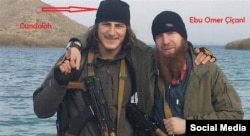While Georgia should be concerned about the issue of citizens fighting in Syria, the government should avoid "inflating the threat beyond the scope of the problem," an analyst has said.
Instead, Georgia should address issues of "endemic poverty and the effect of (usually foreign) radical influencers as key vectors of extremism," Michael H. Cecire, a Black Sea and Eurasia regional analyst and an associate scholar at the Foreign Policy Research Institute, told RFE/RL.
Cecire's comments came in response to the December 9 move by Georgia's parliament to work on a bill to increase accountability for citizens fighting abroad.
The same day, the opposition Free Georgia party urged the government to investigate what it said was the "flow of fighters from Georgia to Syria," RFE/RL's Georgian Service reported.
That move came in the wake of reports in the Russian and Georgian press on December 8 that a Georgian citizen from the Pankisi Gorge region had been killed fighting with the Islamic State (IS) militant group in the Syrian city of Kobani.
There have been discrepancies in the Georgian and Russian media reports regarding the age and name of the killed militant. Some outlets have said he was 21 and others reported that he was 18. Russian outlets said the man was named Zelimkhan Chatiashvili, while a Kist outlet named him as Jabrail Tsatiashvili.
The reports agreed that the man was from Birkiani, the same village in the Pankisi Gorge as Umar al-Shishani, Islamic State's military commander in Syria. The man is almost certainly an ethnic Kist, as is Umar.
While social-media accounts linked to Chechen fighters in IS fighting in Kobani stayed silent regarding the possible death of a fellow militant, Kurdish outlets posted an image that they claimed was the dead man, posing with Umar al-Shishani and taken earlier this year.
While the numbers of Georgians from Pankisi fighting in Syria are not known, local residents have said that between 50-60 Pankisi residents have traveled there to fight.
Recent reports suggesting that as many as 10 Georgian Muslims from the Autonomous Republic of Ajara may also be fighting in Syria will likely increase concerns in Tbilisi.
Cecire says that while the issue of Georgians fighting in Syria is a serious issue, the threat should not be overblown.
"The Pankisi foreign-fighter problem, for example, seems to have gotten far more international attention than in neighboring Azerbaijan, where some credible estimates indicate 200+ foreign fighters originate. Unlike Georgia, returning Azerbaijani fighters represent a genuine threat to the country's stability with ongoing -- and rising -- sectarian tensions after Sabirabad and continued state repression," Cecire says.
Part of the reason for the increased media spotlight on militants from Pankisi, despite their small numbers, is the prominent role played by a handful of Georgian Kists in Syria, particularly Umar al-Shishani.
According to Cecire, reports of Georgian Muslims fighting in Syria -- both Kists from Pankisi and residents of Ajara -- should give rise to questions of "both the Georgian Muslim minority's sense of integration as well as the role of external influences from nearby, otherwise friendly states."
While most of the prominent Pankisi Kists in Syria have a background fighting with the Caucasus Emirate in Chechnya, Umar -- whose father is a Georgian Christian -- appears to have been radicalized while serving time in prison. The radicalization pathways of the younger Kists in Syria, such as Tsatiashvili, remain a mystery.
-- Joanna Paraszczuk

